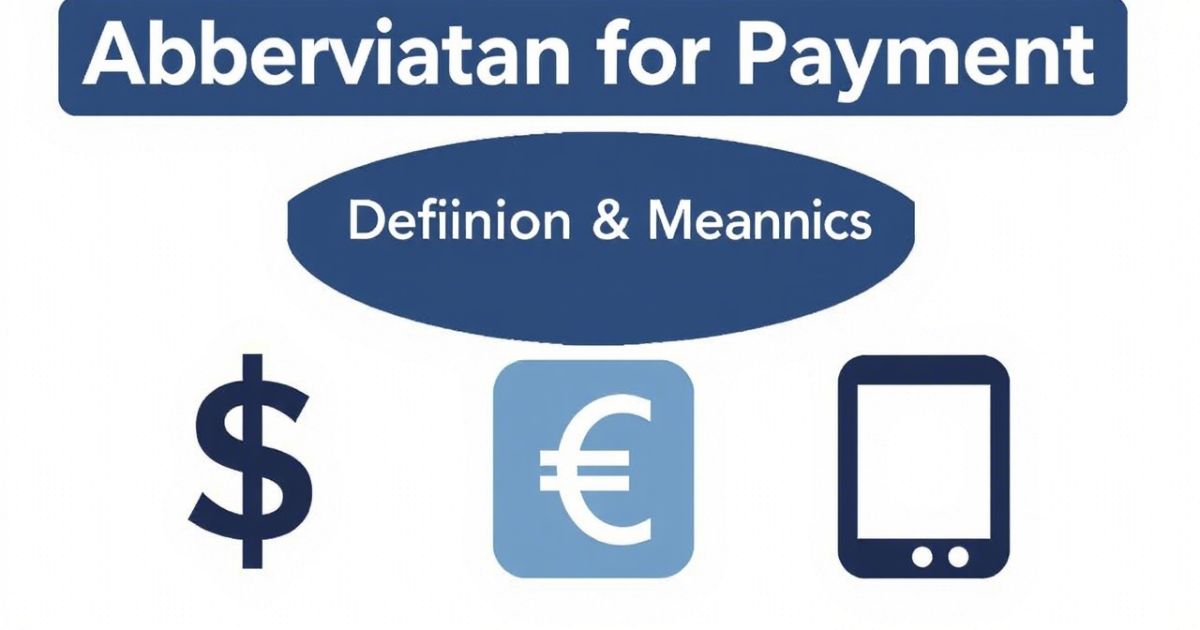The abbreviation for payment is commonly used in business and finance to simplify communication. The most popular abbreviation of payment is “PYMT,” which is a convenient payment short form seen in invoices, receipts, and accounting records. By using an abbreviation for payments, professionals save time and space while maintaining clear records. This is especially helpful when dealing with multiple transactions or managing large amounts of financial data.
So, how do you abbreviate payment? The most common method is using “PYMT” to represent the full term. Many people choose to abbreviate payment in various financial documents to ensure efficiency and clarity. Whether you are working with invoices, bank statements, or payment confirmations, knowing the abbreviation for payment helps streamline the process. The use of the abbreviation for payments is now a standard practice in the business world, making it easier to manage financial documentation.
What is the Abbreviation for Payment?

The abbreviation of payment is commonly used in various financial and business contexts to simplify transactions and communication. The most widely accepted abbreviation of payment is “PMT,” which is used across invoices, contracts, and receipts. This abbreviation of payment helps save time and space when handling financial documents or systems.
When it comes to the abbreviation for payments, some variations may appear based on the context or industry. For example, in accounting, you might also see “Pmt” or “Pay.” These abbreviations for payment are especially useful in digital records or financial reports, where brevity is necessary for clarity and ease of use.
Knowing the correct abbreviation of payment is important in both professional and casual settings. Whether it’s for invoices or receipts, being familiar with how to abbreviate payment ensures clear communication and avoids confusion.
What Does Abbreviation for Payment Mean?
The abbreviation of payment refers to a shortened form used to represent the word “payment” in various financial and transactional contexts. It’s a common practice to abbreviate payment in invoices, contracts, or when discussing transactions. The payment short form is a way to streamline communication in situations where time and space are limited.
When asking how do you abbreviate payment, it’s simple: the abbreviation of payment could be “PMT” or “Pmt,” depending on the usage. It essentially makes reference to an action or a record of a transaction without needing to spell out the full word “payment” each time. Using abbreviations for payments helps avoid redundancy, especially in professional documents or accounting systems.
Understanding the abbreviation of payment allows individuals and businesses to communicate effectively and professionally. Abbreviating payment saves time and resources while maintaining clarity in financial documentation and discussions.
Definition, Pronunciation, and Examples
The abbreviation of payment is a shortened form of the word “payment,” typically used in financial documents, transactions, and communication. The most common abbreviation of payment is “PMT,” although other variations like “Pmt” or “Pay” are also used depending on the context. Using the abbreviation for payments helps streamline communication, making it easier to handle invoices, receipts, and financial records.
The pronunciation of the abbreviation of payment, “PMT,” is typically spoken as the individual letters: “P-M-T.” It’s important to note that while the abbreviation of payment is primarily used in written form, when spoken, the full word “payment” may be used for clarity, especially in verbal communication. The pronunciation of payment itself is “PAY-ment,” with emphasis on the first syllable.
Here’s how you might use the abbreviation of payment in sentences:
- Full term: “The payment was processed successfully and sent to the vendor.”
Abbreviation: “We’ve received your PMT for the invoice.” - Full term: “The payment is due within 30 days of the purchase.”
Abbreviation: “Your Pmt is due by the end of the week.” - Full term: “Please ensure the payment is made promptly to avoid delays.”
Abbreviation: “The Pay for your subscription will be charged tomorrow.” - Full term: “He made the final payment for the car loan last month.”
Abbreviation: “The final Pmt of $1,000 has been completed.” - Full term: “The payment was successfully completed through the online portal.”
Abbreviation: “You’ll see the Pmt reflected in your account soon.”
Pronunciation and Common Uses of PYMT
Pronunciation and Common Uses of PYMT
The abbreviation “PYMT” for payment is typically pronounced by saying the individual letters: “P-Y-M-T.” While “PYMT” is a convenient shorthand, it’s mainly used in written formats like invoices, receipts, and financial records. It’s less commonly pronounced verbally, as the full word “payment” is usually preferred in conversation. However, in written communications like financial documents or digital systems, the abbreviation of payment, PYMT, is widely accepted and helps streamline processes.
Common uses of “PYMT” include:
- Invoices and Receipts: “PYMT” is often used in financial statements or receipts where space is limited.
- Accounting and Bookkeeping: It’s used to represent payments in financial ledgers or balance sheets.
- Online Payments: Platforms or systems that process transactions may display “PYMT” in user interfaces to indicate a payment transaction.
Other Examples
Here are some examples similar to the one you provided:
- PYMT for “Payment” – This abbreviation is used to represent a financial transaction or the act of making a payment in invoices, receipts, or accounting records.
- INV for “Invoice” – This abbreviation is used when referring to a document issued by a seller to a buyer indicating the products or services provided and the amount owed.
- BOL for “Bill of Lading” – This abbreviation is used to refer to a shipping document issued by a carrier to acknowledge receipt of cargo for shipment.
- POC for “Proof of Concept” – This abbreviation is used to describe a demonstration or pilot project that verifies the feasibility of an idea or technology.
- ROI for “Return on Investment” – This abbreviation is used to measure the profitability or effectiveness of an investment relative to its cost.
- ETA for “Estimated Time of Arrival” – This abbreviation is used to indicate the expected arrival time of goods or people to a specific location.
- TBD for “To Be Determined” – This abbreviation is used when details are not yet finalized or available.
Short Abbreviation for Payment
The short abbreviation of payment is often “PMT.” This abbreviation is used across various documents like invoices, receipts, and financial records. It helps to simplify communication, especially in professional or business settings where space and time are important.
In addition to “PMT,” other short abbreviations for payment include:
- Pmt – Another common abbreviation often seen in invoices, receipts, and financial records.
- Pay – A simplified form used in certain contexts where the full term “payment” is unnecessary.
Acronym for Payment
An acronym for payment could be “Pmt,” which is a commonly used shorthand in accounting and finance. It is frequently seen in electronic systems, bills, and transaction statements. While it functions similarly to an abbreviation, an acronym typically represents the first letters of the word or phrase.
Besides “Pmt,” acronyms related to payment include:
- PYO – Stands for “Pay Your Order,” commonly used in e-commerce platforms.
- EFT – Electronic Funds Transfer, referring to the digital transfer of money between banks or accounts.
- ACH – Automated Clearing House, a payment network that facilitates direct payments between financial institutions.
Related Guide:
Occasion or Ocassion: What’s the Correct Spelling?
Synonyms for Payment
Synonyms for payment include:
- Remittance – Refers to a sum of money sent as payment.
- Settlement – Used to describe the completion of a financial transaction.
- Compensation – Often used in contexts where someone is paid for services or work.
- Disbursement – A term commonly used for the act of paying out money, particularly in business or governmental settings.
- Reimbursement – Refers to the repayment of expenses.
- Transaction – A broad term that refers to any exchange of goods or services for payment.
- Fee – A specific charge made for a service rendered or product provided.
- Installment – A payment made in parts, rather than as a lump sum.
- Honorarium – A payment made for professional services, typically to someone who is not legally obligated to accept payment.
- Wage – A regular payment made for work performed, often used for hourly or salaried employees.
- Salary – A fixed regular payment, typically on a monthly or biweekly basis, made by an employer to an employee.
- Stipend – A fixed sum of money paid for services or to cover expenses, often used in academic or internship contexts.
Antonym for Payment
The antonym for payment could be:
- Debt – Represents the amount owed and the opposite of a completed payment.
- Refund – Refers to money returned to a customer, often because of an overpayment or return of goods.
- Charge – Refers to the cost or fee incurred, which is to be paid later.
- Arrears – Money that is owed but has not been paid yet.
- Outstanding balance – The amount of money still owed on a debt or invoice.
- Deficit – A situation where expenses exceed available funds, indicating non-payment.
- Non-payment – The act or state of failing to pay for something when due.
- Overdue – When payment is past the due date and has not been made.
The History of the Word Abbreviation for Payment
The abbreviation of payment has its roots in the need for quick and efficient communication in business and finance. In the early days, financial records were often written manually, and clerks used the abbreviation for payments to save time and space. The payment short form became especially important in accounting, where long forms of the word “payment” would take up unnecessary space in ledgers and invoices. By shortening the word, businesses could process more documents faster and more effectively.
As technology advanced, especially with the rise of typewriters and computers, the need for the abbreviation of payment grew. Systems and financial software began adopting the abbreviation of payment to make it easier to record and track transactions. The ability to abbreviate payment became a standard practice in accounting software, making it more efficient to process payments and update records. These abbreviations for payments allowed for quicker entry of information in digital systems, reducing errors and increasing productivity.
The use of the abbreviation of payment has remained prevalent in today’s digital world. Financial institutions, businesses, and accountants continue to use the payment short form to process transactions. When asking, how do you abbreviate payment, the answer is simple, using “PMT” or “Pmt.” These common abbreviations for payment help keep financial documents concise while ensuring that transactions are processed accurately and promptly, reflecting the evolution of business practices over time.
When should the abbreviation for payment PYMT be used?
The abbreviation of payment “PYMT” should be used primarily in situations where brevity is essential, such as in financial documents, receipts, invoices, or accounting systems. It helps streamline communication and makes financial records more concise. In environments where space is limited, like on digital forms or in financial statements, using the abbreviation of payment can save valuable space without sacrificing clarity.
Another common use for the abbreviation of payment is in automated systems or software applications that track transactions. When entering payments into accounting software or online banking systems, it’s more efficient to use the payment short form “PYMT” instead of writing out the full word “payment.” This simplifies data entry and ensures consistency across financial documents, especially in large-scale operations where multiple transactions are processed regularly.
The abbreviation of payment “PYMT” is most effective in specific situations where conciseness is required. Here are a few key scenarios where it should be used:
- In Financial Statements and Invoices: When preparing invoices, receipts, or balance sheets, the abbreviation of payment “PYMT” can help save space and maintain a clean, concise layout. It’s particularly useful in documents with numerous financial entries, where using the full word “payment” would clutter the page.
- In Accounting and Bookkeeping: Accounting software and ledgers often feature the payment short form “PYMT” for quick data entry. This allows accountants to track multiple payments in an efficient manner, especially when managing bulk transactions or reconciling accounts.
- In Online Payment Platforms: Many online payment systems, such as banking apps or e-commerce platforms, use the abbreviation of payments to display transaction details in a simplified manner. The use of “PYMT” makes it easier for users to understand their payment history without overwhelming them with long-form language.
- In Legal and Contractual Documents: When referring to payment schedules or terms in contracts, especially where multiple payments are involved, the abbreviation of payment can be used to clearly outline due dates and amounts, making the document more manageable and easier to read.
- In Internal Communications: If you’re communicating with colleagues or clients within your company regarding payments, using “PYMT” can streamline messages and keep the focus on important details. It’s particularly useful in internal reports or financial updates where space or time is a factor.
- In Transaction Records or Payment Receipts: When tracking payments, such as in bank statements or receipts, the abbreviation of payment “PYMT” helps indicate that a transaction was made without having to write out the entire word. It ensures clarity in records while also improving the speed of processing information.
Example of the Word and Abbreviation in Context

Here are some examples showing how the full term “payment” and the abbreviation for payment “PYMT” can be used in context:
- Full term: “The payment of $200 was made via credit card for the monthly subscription.”
- Abbreviation: “The PYMT of $200 has been processed successfully.”
- Abbreviation: “The PYMT of $200 has been processed successfully.”
- Full term: “Please ensure the payment is received by the end of the month to avoid penalties.”
- Abbreviation: “Make sure the PYMT is submitted by the due date.”
- Abbreviation: “Make sure the PYMT is submitted by the due date.”
- Full term: “Your payment for the service was due last week.”
- Abbreviation: “Late PYMT will incur an additional charge of 5%.”
- Abbreviation: “Late PYMT will incur an additional charge of 5%.”
- Full term: “The payment has been verified and the account balance is now up to date.”
- Abbreviation: “The PYMT has been confirmed, and your account is in good standing.”
- Abbreviation: “The PYMT has been confirmed, and your account is in good standing.”
- Full term: “We require full payment before the goods are shipped.”
- Abbreviation: “Please submit the PYMT before we can proceed with your order.”
- Abbreviation: “Please submit the PYMT before we can proceed with your order.”
These examples highlight the efficient use of the abbreviation of payment “PYMT” in different financial contexts, making communication clearer and more concise, especially in written forms like invoices or digital systems.
FAQ’s
What does the abbreviation of payments mean?
The abbreviation for payment is commonly used to shorten the word in financial documents. It simplifies writing and improves efficiency in accounting records.
How is payment abbreviated?
When you want to shorten the term “payment,” use the abbreviation for payment like “PYMT.” It’s widely recognized in various financial transactions and documents.
Why is the abbreviation of payment important?
Using the abbreviation for payment in financial documents saves space and time. It keeps records concise and makes it easier to process multiple transactions efficiently.
Where is the abbreviation of payment used?
The abbreviation for payment is used in invoices, receipts, and banking systems. It helps maintain clarity and accuracy while reducing clutter in financial records.
When should I use the abbreviation of payment?
Use the abbreviation for payment in documents where space is limited, such as digital forms or accounting software. It’s ideal for transactions requiring quick data entry.
Conclusion
The abbreviation for payment is an essential tool for simplifying financial communication. The most common abbreviation for payment is “PYMT,” which serves as a useful payment short form in invoices, receipts, and accounting records. By using the abbreviation for payments, businesses and professionals can keep their financial documents concise and easy to manage. It saves time and space, especially when handling multiple transactions.
If you’re wondering how do you abbreviate payment, the answer is simple: use “PYMT.” It’s a standard and widely accepted way to abbreviate payment in many financial contexts. Whether you are dealing with invoices, bank statements, or transaction records, the abbreviation for payment ensures clarity and efficiency. Using the abbreviation for payments helps businesses stay organized and ensures that financial communication remains streamlined and straightforward.

Ember Rose is a dedicated administrator with 4 years of experience in efficient operations management and team leadership. Skilled in streamlining workflows and enhancing productivity.

